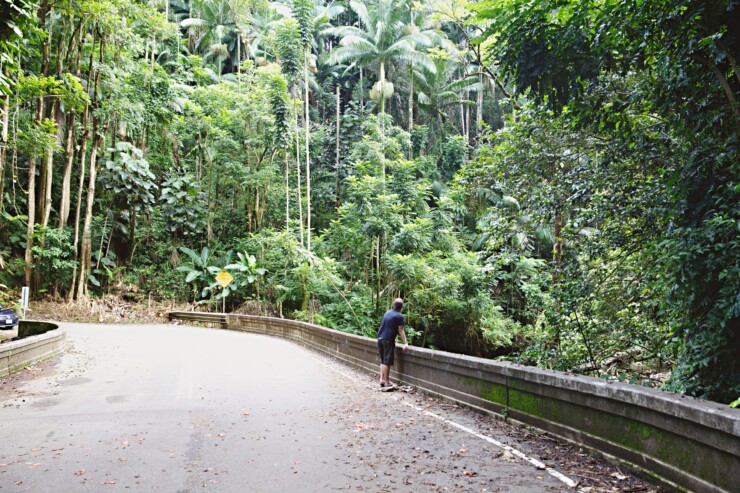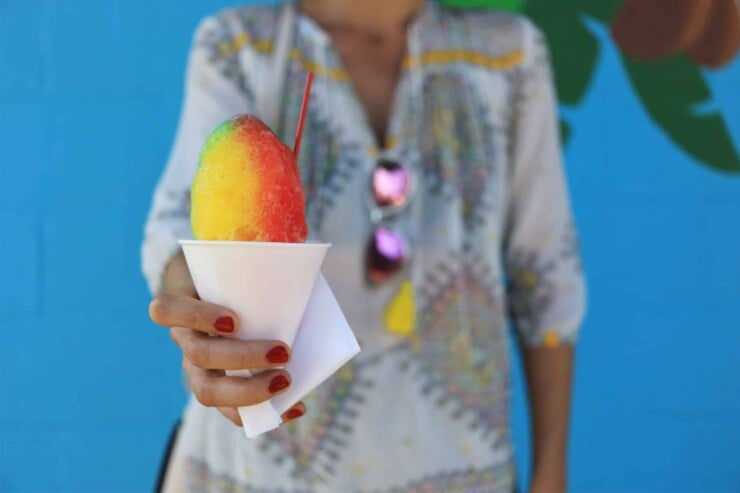Yes, Kona coffee may not be native to Hawai’i, but it’s been around long enough that it’s just as local as malasadas and butter mochi. You see, coffee (and what would become Kona coffee) was first planted in Hawai’i in 1817. It even outlasted the sugar industry, which dominated the Island’s economy from the mid-1800s until the 1990s.
Here, we’ll be diving deep into the subject because one mention of Hawaiian coffee, and the first thing that comes to mind is Kona coffee. As a travel writer and editor, I’ve spent over a decade researching and writing about travel. I was born and raised in Hawai’i and have traveled there extensively. I love the islands’ culture and encourage you to explore its food scene (including coffee) when visiting.

What Is Kona Coffee?
We’ll cover the history of Kona coffee, its rise to fame through the centuries, how it’s made, where to buy it in Hawai’i, and more. But first, let’s answer the question, What is Kona coffee?
In Hawai’i, Kona Coffee is a regulated term. Only coffee grown within twenty miles of Mamalahoa Highway in Hawai’i Island’s Kona district can be labeled Kona Coffee. This area is known as the “Kona Coffee Belt.”
Yes, coffee exists elsewhere around the Big Island of Hawai’i and other Hawaiian islands, including Kaua’i and Maui, but Big Island coffee makes up 90 percent of the state’s coffee production.

A (Brief) History Of Coffee In Hawai’i
The missionary Samuel Ruggles is widely credited for how coffee originally got to the Island of Hawai’i. He brought coffee to the Island of Hawai’i in 1828, where it took well to the unique environment of volcanic soil rich in nutrients, high elevation, and cooling cloud cover.
A handful of coffee plantations and farms established themselves in the next decade, like Greenwell Farms in 1850. Founded by English businessman Henry Nicholas Greenwell, today it is one of the area’s largest and oldest Kona coffee farms.
Between 1840 and 1945, most of Kona’s coffee farming and production was done primarily by Japanese, Chinese, and Filipino laborers searching for work after their sugar contracts expired. Americans, Europeans, and Hawaiians owned the land.
Many laborers leased small acreages of land to grow coffee, gain financial independence, and build a life. That’s why many of today’s Kona region coffee farms are multi-generational.
Today, more than 600 farms produce it within the narrow “Kona Coffee Belt” on the western slopes of Mauna Loa and Hualālai volcanoes on the island’s western side. Ka’ū, Puna, Hilo, and Hāmākua also grow coffee.

How Did Kona Coffee Become Famous?
Kona coffee’s popularity is attributed to several events. One is that in 1842, the Hawaiian government encouraged coffee production by allowing coffee beans as a tax payment.
There was also a brief boom during the California Gold Rush (1848-1855), where coffee found a market in the Golden State. In later years, Greenwell Farms’ Kona coffee gained recognition at the 1873 World’s Fair in Vienna, Austria, which attracted international investment.
How Is Kona Coffee Made?
Before it makes it to your cup, there is extensive work for Kona coffee farming. Most coffee cherries are first hand-picked from coffee trees and pulped to remove skins and expose the beans. At this point, Kona beans are left with a parchment encasing. Beans at this stage are then typically sun-dried for up to a week, then hulled, roasted, and cooled.
During harvesting, a coffee bean or seed will reveal one bean instead of the typical two. This is rare; it’s considered Kona peaberry coffee when enough is harvested. Kona coffee is made from arabica beans, and while it’s its variety today (Kona Typica), it evolved from the Guatemalan Typica variety.
What Does Kona Coffee Taste Like?
Like wine, tequila, and mezcal, coffee’s taste is informed by its growing conditions, such as climate and soil content. A good cup of Kona brew, therefore, has a unique flavor.
Typically, Kona coffee has a light, smooth, and mildly sweet flavor profile with a somewhat floral aroma. It’s also described as complex due to the minerals in the rich volcanic soil. Since it’s cooler in the highlands of Hualalai and Mauna Loa volcanoes, coffee cherries mature slower than coffee grown at lower elevations, giving beans more time to develop nuances to their flavor profile.

Why Is Kona Coffee Special (And Expensive)?
From its distinct growing conditions to its small batch production compared to coffee production in other parts of the world like Brazil, Ethiopia, and Colombia, Kona coffee isn’t your average cup of coffee.
Legit Kona coffee is quite rare, which is why it’s often considered a premium coffee. It accounts for 1 percent of global coffee production, and Hawai’i is the only U.S. state producing coffee commercially. California recently began cultivating coffee, but it’s still experimental.
Speaking of legitimacy, as mentioned previously, the term “Kona Coffee” is tightly regulated by the state of Hawai’i, similar to how Italy’s Parmigiano Reggiano is a Protected Designation of Origin (PDO) product. What this means is that coffee beans must have been grown within the borders of the North and South Kona districts.
If we’re talking coffee blends (labeled “Kona Coffee Blend”), the product must contain a minimum of 10 percent Kona coffee beans to use the term on a label. But that’s changing, as pending legislation would increase the percentage minimum to 51 percent. On the other hand, pure Kona coffee will be labeled 100% Kona.
Kona coffee is mostly expensive because it is produced in the United States, where labor costs are higher than in other coffee-producing countries. Shipping costs from the islands to the mainland are another factor.

Where To Buy Kona Coffee
But we’re all about supporting local at Salt & Wind, and as such, one of the best ways to buy 100 percent Kona coffee is to purchase it directly from coffee farms.
For example, the Kona Coffee Farmers Association lists its 63 member farms, most of which are small, family-run operations. When it comes to the best Kona coffee farm, Kona’s farms range from long-established plantation farms to newer operations.
Most farms host Kona coffee tours if you’re on the Big Island and want to dive deeper. Local Hawai’i roasters sell Kona coffee, too, like Big Island Coffee Roasters and Royal Kona Coffee (if you’re uber-familiar with the islands, they make Lion Coffee).
Frequently Asked Questions
Kona coffee is celebrated for its unique flavor profile and high quality, attributed to the distinctive climate and volcanic soil of the Kona Coffee Belt on the Big Island of Hawaii.
This narrow stretch of land offers ideal coffee-growing conditions, including rich soil, sunny mornings, and rainy afternoons. Kona coffee beans are hand-picked and meticulously processed, resulting in a smooth, rich coffee with a balanced flavor that often includes hints of nuts, spices, or chocolate.
Authentic Kona coffee is exclusively grown in the North and South districts of Kona, on the Big Island of Hawaii. Genuine Kona coffee should have a certification label from the Hawaii Department of Agriculture, indicating it meets the quality standards and origin requirements.
Be cautious of blends that contain only a small percentage of Kona coffee; authentic Kona coffee will be labeled as 100% Kona coffee. Always purchase from reputable sellers or directly from the coffee farms when possible.
Yes, many Kona coffee farms offer tours to visitors, providing a firsthand look at coffee production from bean to cup. These tours often include walking through the coffee orchards, harvesting and processing methods demonstrations, and coffee tastings.
It's an excellent opportunity to learn about the history and culture of Kona coffee farming, and to purchase fresh coffee directly from the source.
Get A Personalized Travel Itinerary

All About Shave Ice
Speaking of food and drinks from Hawai’i, you’ll want to try local treats like malasadas and shave ice while in the Aloha State. To get the lowdown, read all about shave ice, including how it first came to Hawai’i and why it’s “shave ice,” not “shaved ice!”
Have Us Plan Your Hawaiʻi Trip
Did you know we’re also a boutique travel agency specializing in Hawaiʻi vacation planning? If you want to plan a trip to Hawaiʻi, our Hawaii trip planner services are here to help you plan your perfect itinerary.
Photo Credit: Opening photo by Blake Wisz; Waterfall photo by Jakob Owens on Unsplash; Coffee berry photo by Katya Ross on Unsplash; Young Man Sitting In Lawn Chair Sips From A Coffee Cup Near A Grove Of Palms by Luke Mattson
Hawaiian Diacritical Marks: In an effort to be accurate and respectful of the Hawaiian language, we use diacritical marks in our articles on the region. For more about which marks are used in the language and how to find proper spelling, refer to this Hawai’i Magazine article.